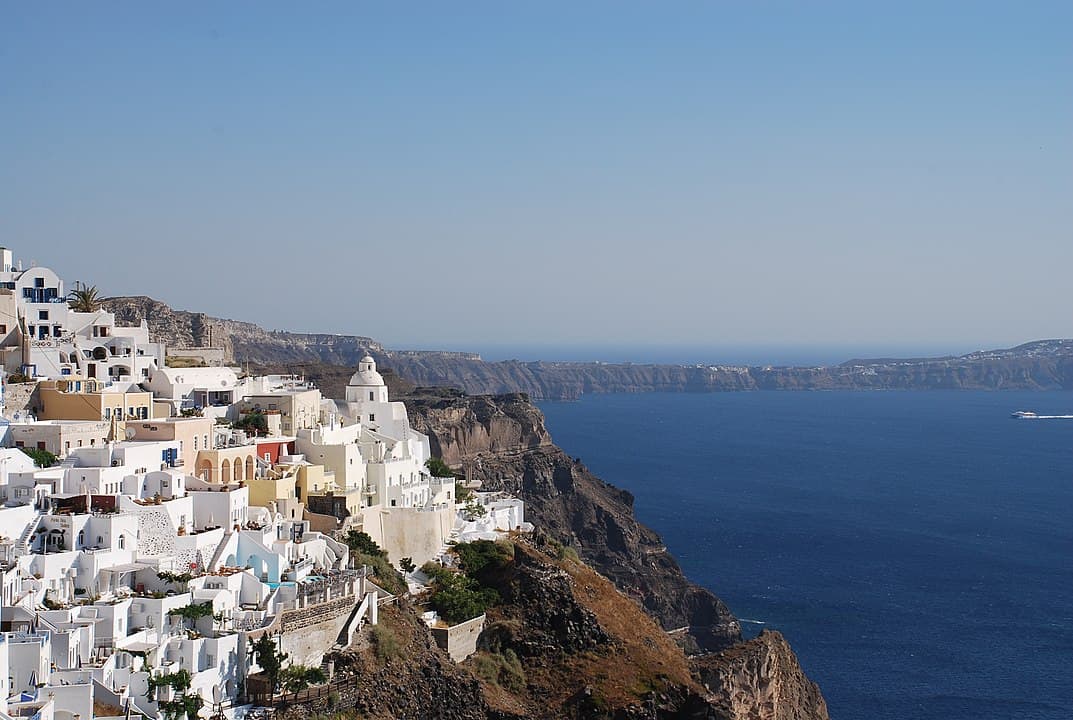
Santorini aka Thera aka Thira is an archipelago within an archipelago in Greece. Comprising of 5* primary islands — Santorini Island, Thirassia, Nea Kameni, Palea Kameni & Aspronisi —Santorini lies in the Cyclades group of islands southeast of mainland Greece. However, Santorini is much more than just another island in the Aegean Sea, painted in white and looking Instagram-worthy. What makes Santorini unique is that it’s built along a crater – a real volcanic crater. We have to get into the Geography of the place to understand this Greek destination. All of this, and more, is included in my Santorini travel guide!
Geography
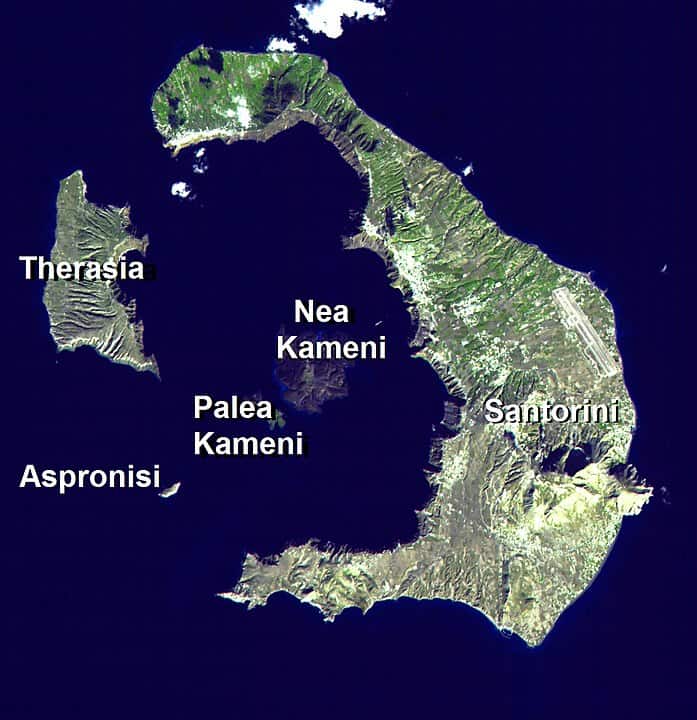
If you look at the lay of the land, you will see that there could’ve been one big volcanic island here, and that it could have erupted… and then the mouth of the volcano could have gotten flooded by the Aegean. And that is exactly what happened here.
Santorini Island (the biggest of the lot), Thirassia & Aspronisi are parts of the original rim of the volcano. And the two islands towards the middle are volcanoes within the volcano.
What to see and do in Santorini
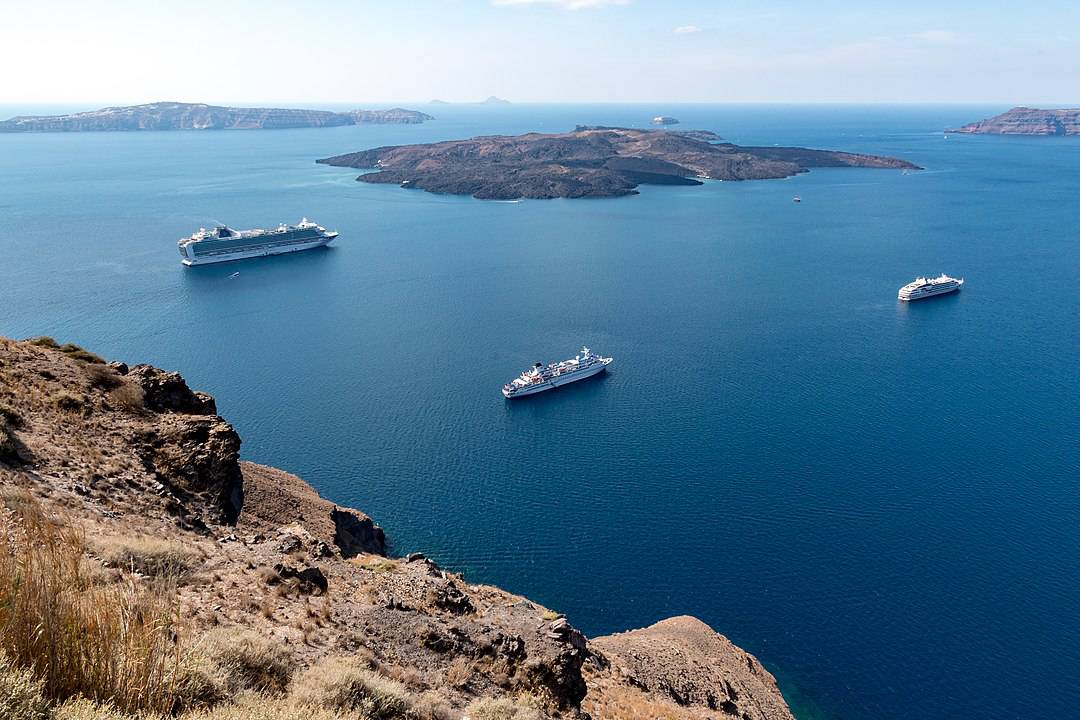
So what do you do in Santorini? Of course that’s included in my Santorini travel guide! Most people come to Santorini to stay and walk on the rim of the volcano. Other attractions here are the architecture, the beaches, the wine & the Santorini sunsets.
Now, when you hear of someone traveling to Santorini, it almost always means the main island of Santorini. This crescent-shaped and biggest island is where all the hotels, restaurants and most of the attractions of ‘Santorini’ are.
Oia, the town on the Northern end of the island is where a lot of tourists end up. They say this is the best spot on the island for those signature Santorini Sunsets. Oia also has many of the blue domes that the island is known for, several recommended eateries and the Oia Castle. Just below the town is Ammoudi Bay known for its seafood joints and for cliff jumping & swimming.
Towards the middle on the west coast of Santorini are the towns of Fira, Firostefani and Imerovigli, all tourist-friendly and offering views of the caldera. Fira is the capital of the island and the commercial center too. Walk down to the caldera from here and you will find yourself in the Port of Fira. Walk the trail on the rim and you’ll see that it connects Fira to Oia via Firostefani and Imerovigli.
On the lower western end of Santorini is the Akrotiri Lighthouse, another area that offers panoramic views of the caldera and the rest of the island. On the southern and eastern parts of Santorini are several beaches, some with black sand. You will also find a red sand Beach and a white sand one on the southern coast.
Away from the caldera and towards the heart of the island is where a number of wineries and some of the agricultural areas lie. The volcanic soil of Santorini seems to be conducive for vine & tomato growing.
As for the architecture, Santorini is a showcase of Cycladic buildings and paintings (cubical and white in color) with some Venetian touches here and there. Make sure to see and cross off your list of architectural finds like cave houses, churches with blue domes, monasteries & castles.
Another must-do while in Santorini is to take a boat or catamaran tour to the volcanic islands in the middle of the caldera!
Check out my list of Top 10 things to do in Santorini for even more details than are included in this Santorini travel guide.
History
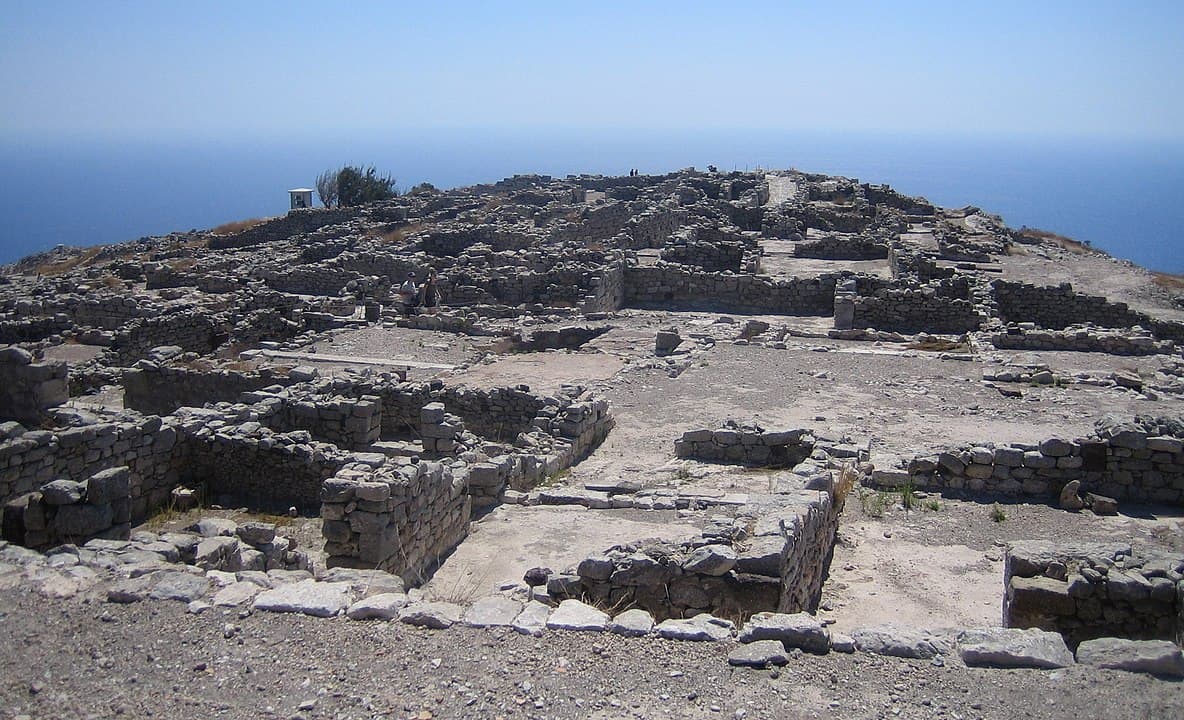
Speaking of volcanic activity, let me tell you that it has played a BIG role in Santorini’s history. The story of the land goes back to the BC days, to the Minoan Civilization. And when the big eruption happened, the civilization that was based in Crete and the southern part of present-day Santorini came to an end. Proof of that lies in the ancient city of Akrotiri that was found buried under tons of volcanic ash.
A part of the prehistoric city has been unearthed and is open for visitors to see some of the finds from the ancient city of the Bronze Age.
Other sets of ruins that share the history of Santorini are Ancient Thira and the Akrotiri Castle, around which the village of Akrotiri has been developed. Ancient Thira is situated on Mesa Vouno towards the eastern side of the island. Hike up the mountain and you will see remains from Santorini’s Roman past and some amazing views from the top of the mountain.
History buffs can also learn more about the ancient volcanic Island at the Museum of Prehistoric Thera in Fira and the Megaro Gyzi Museum. There’s also the Folklore Museum, also in Fira.
You can also learn about the island’s Wine History at the Wine Museum in Vothonas. And for the tomato-growing history of Santorini, there’s a Tomato Industrial Museum at Vlychada.
What to eat in Santorini
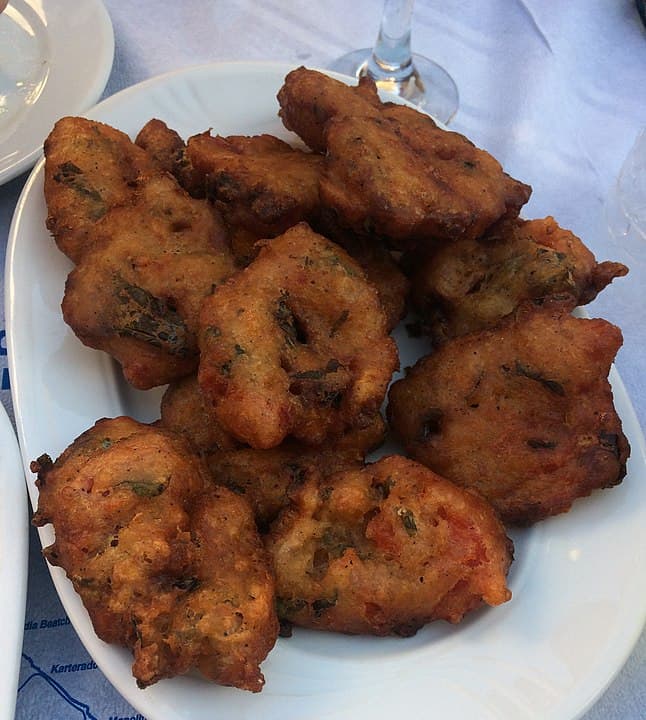
While you are visiting these islands in the southern part of the Cyclades, make sure you taste Santorini’s famous cherry tomatoes. Some of the special tomato dishes here include the Santorini Salad that has local tomatoes and the tomato keftedes. Other specials of the island include items made Fava Beans, White Eggplant and Capers.
A visit to Santorini also means sampling the wine made right there. There are several wine tours you can indulge in!
Speaking of indulgences, I highly recommend you have at least one meal at any of the restaurants that offer a caldera view, even though it is a bit more expensive than ones that don’t. Dinner with a sunset view would be another ultimate Santorini experience.
Check out these Top Restaurants in Santorini for more than what is included in this Santorini travel guide.
Where to Stay
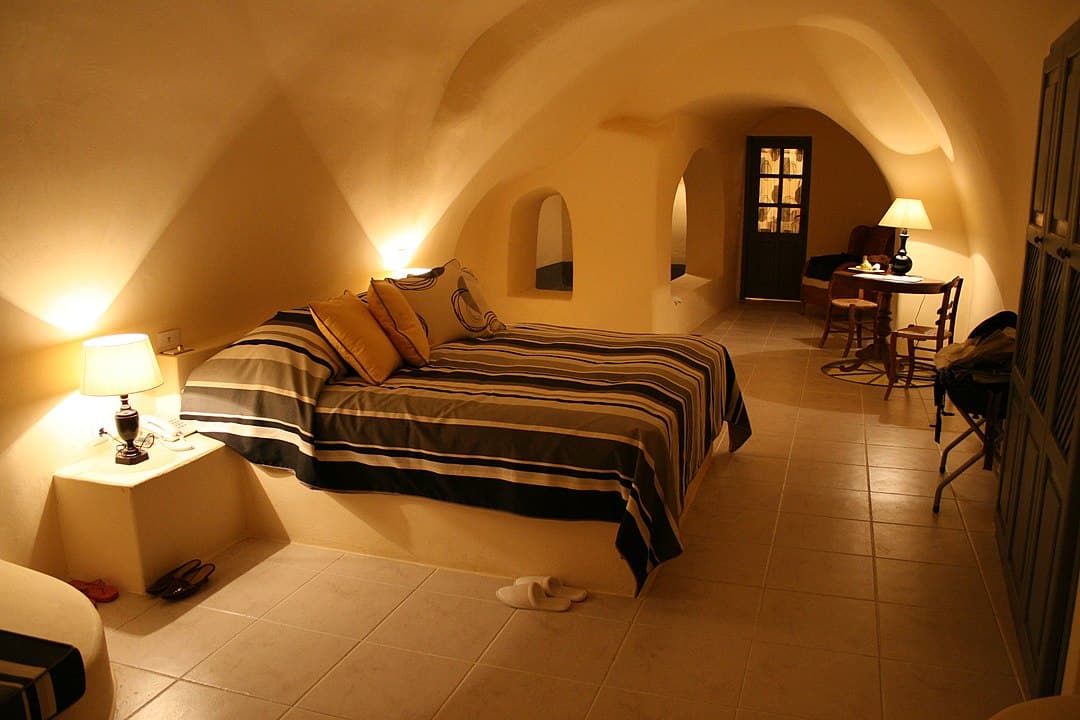
Typical Santorini accommodation would be to stay in a hotel/apartment that overlooks the caldera. I would also recommend you look for a cave room built into the cliffs. There’s even a windmill you can stay in, here on the island!
If you are looking for a relaxing stay by a beach, you could look for accommodations on the eastern coast of Santorini.
Other factors you could look into when it comes to picking a hotel room: Oia and Fira are the touristy parts to stay. Oia is also very picturesque and is considered the sunset town of Santorini. Fira, on the other hand, is the center of public transport. Most of the nightclubs of the island are also around here.
Transportation

The ways to get yourself to Santorini are by cruise, ferries or planes. You will find that there are more flights in the summer months.
To get around the island, your options are taxis, buses & boats. You can also rent cars and ATVs. Santorini is pretty pedestrian-friendly too (don’t forget to pack your walking shoes).
Shopping

Fira and Oia are your main souvenir shopping areas, although you’ll find some stores in the other quieter villages too. When you are looking for gifts, some good options are jewelry, ceramics, tomato seeds & Santorini’s famous wines.
You might also want to pick up a book or two at the Atlantis Bookstore in Oia. The store is an attraction by itself.
Best time to visit
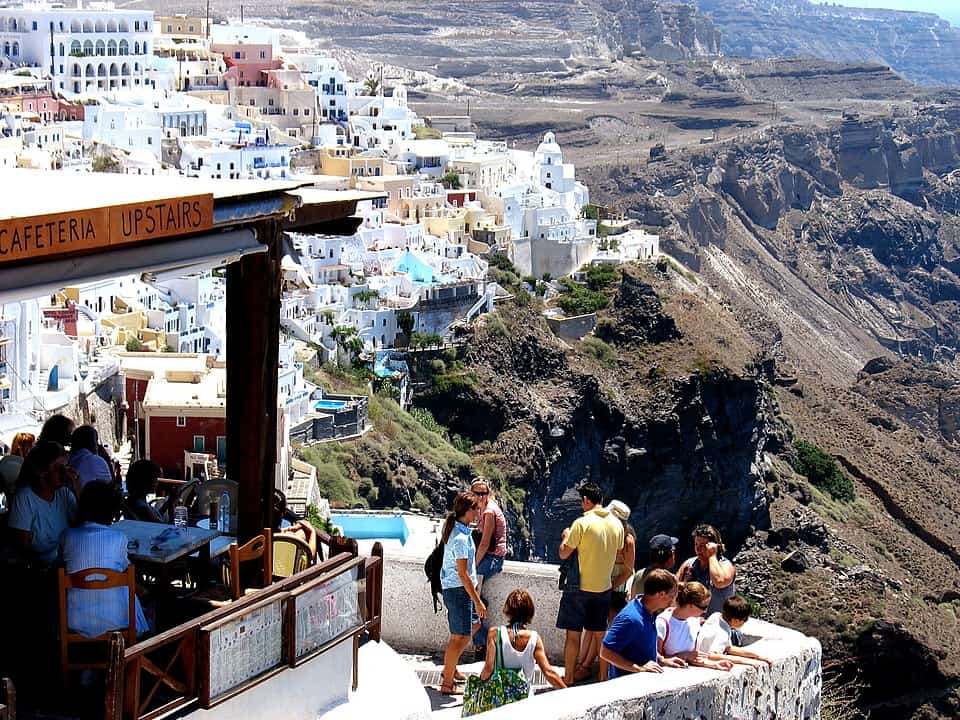
Santorini’s peak season is from June to August. If you would like to go when the crowds are smaller, you can visit in April or May or wait until September or October. During these months your holiday might not be as expensive as in the summer months, but you might find some popular hotels and restaurants closed.
In winter, the island has its colder, rainier months and turns into a quiet place.
Nearby Destinations
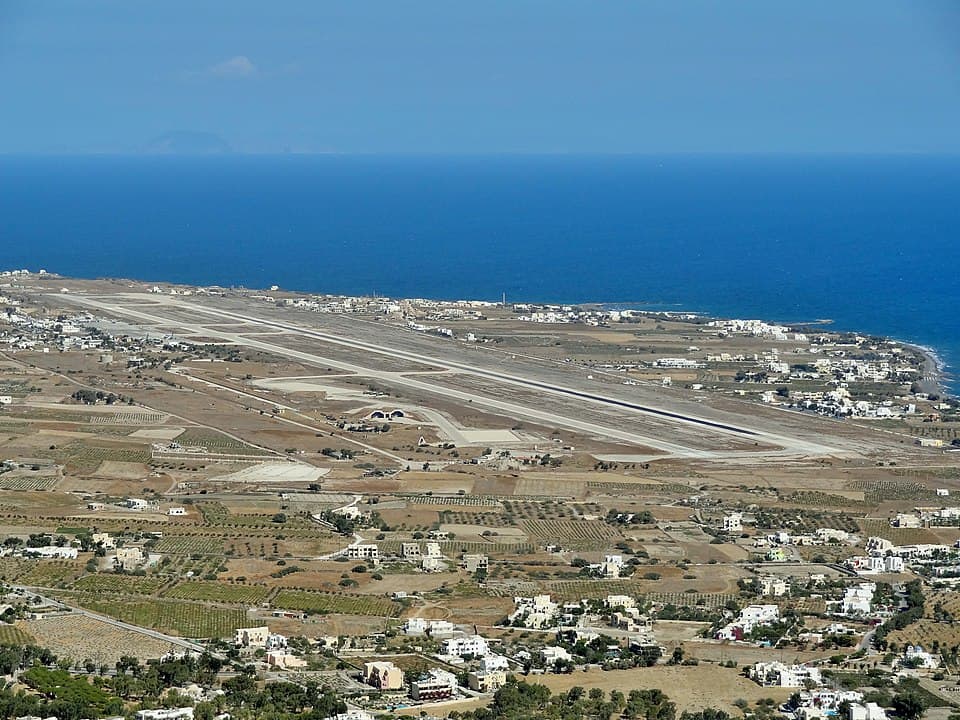
Despite being a Santorini travel guide, there are some other nearby places that I have to include that you don’t want to miss. Santorini is a 45-minute air trip away from Athens, the capital of Greece. If you are sailing, Athen’s port city, Piraeus is around 125 miles away from the island. Mykonos is around 95 miles to the North and Crete, 85 miles to the South.
*There are some other islands away from the primary islands of Santorini that fall under the Municipality of Santorini.